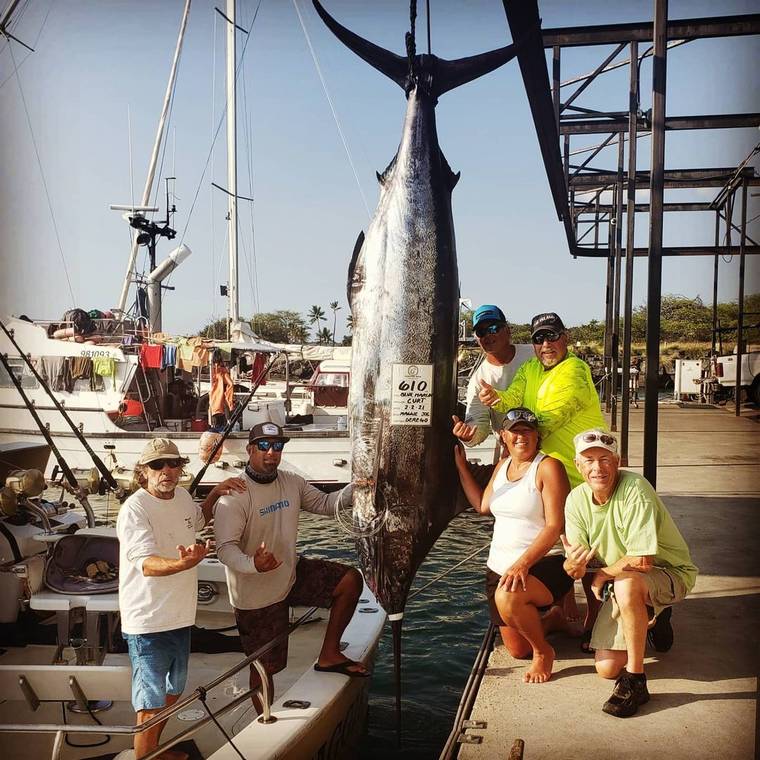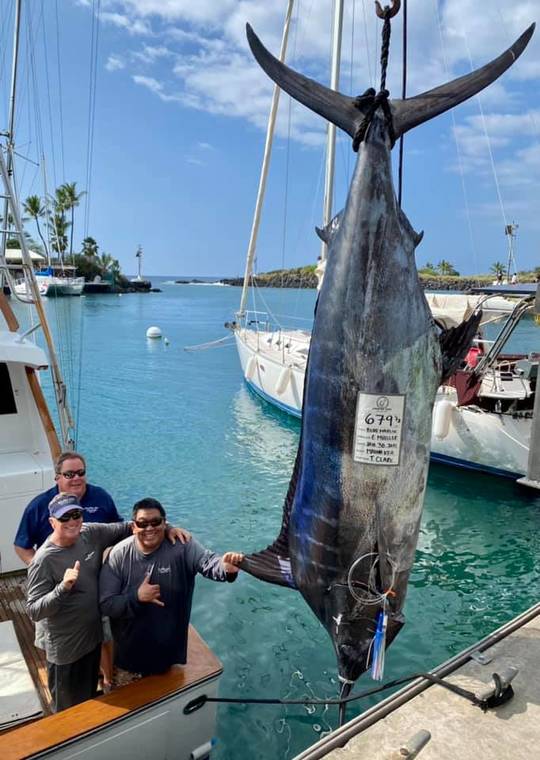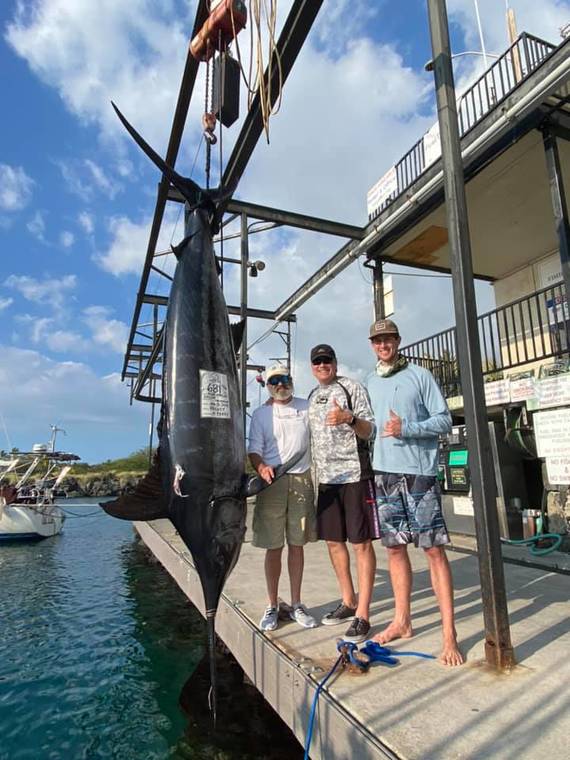The Bright Side: Fishing by the Googler

Capt. Mike Derego and his band of merry friends celebrate the most recent and third on the big fish list, a 610 pounder from “Maggie Joe." (Kona Charter Desk/Courtesy Photo)

The crew of "Mauna Kea" stands with their 679.5 pound marlin, the second largest of 2021. (Kona Charter Desk/Courtesy Photo)

The crew of "Rocket" is all smiles with the biggest marlin so far in 2021 — a blue weighing 681.5 pounds. (Kona Charter Desk/Courtesy Photo)
You know, it seems like the googler has turned just about everything into a one stop shopping experience. Some things, however, remain hard to find on the internet.
You know, it seems like the googler has turned just about everything into a one stop shopping experience. Some things, however, remain hard to find on the internet.
In recent weeks photos popped up here and there of some decent marlin caught along the Kona Coast, but trying to find a single source for them ended up to be a bit of an easter egg hunt. Three fish weighed in over 600 pounds, so the search for their stories began in earnest.
The Charter Desk at Honokohau was the central depository for fish catch reports for a number years. With the expansion of the internet, boat owners took to developing their own marketing in hopes of saving on booking agent commissions. All the boats have their own websites now, and of course, want to capture their own “unique visitors.” Most boats practice tag and release these days as well, so few fish are weighed. And then the Charter Desk shut down. If you aren’t out enough to know, you have to surf from site to site to see what is being caught.
A few years ago, Capt. Bryan Toney established the Kona Marlin Report on Facebook. It became a good central reference point until Covid slowed charter fishing, but it seemed a good place to start looking for posts of these three hefty marlin. “Marlin Magic II” had a few pictures up showing mixed bag catches and “Kraken” had some nice tag and release posted. It looked like fishing was pretty good, but there were no 600 pounders to be found on the 2021 Kona Marlin Report page.
The Kona Charter Desk has reopened, and the googler found their new website. The search was getting warmer.
Indeed, there was a photo of a fish that weighed 610 pounds, caught by the crew on “Maggie Joe” February 2, 2021. However, the only other photo posted since New Years was of a 35 pound mahi mahi, just under 600 pounds shy of being a 600 pounder.
Back to the googler, which said the Kona Charter Desk had a Facebook page. With just one click — voila! There were guys from a boat called “Rocket” standing with a 681.5 pounder. This fish is on top of the Kona big fish list for 2021, so far.
The fish on “Rocket” just barely edged out a fish caught only the day before — a 679.5 pound blue caught on “Mauna Kea.” Capt Tony Clark laughed and said, “Yeah, we held the lead on the big fish list for about twelve hours, but we were happy because we were getting lots of bites. There were other nice ones mixed in there too. We had our shots.”
The Kona Charter Desk page showed a couple more marlin around 500 pounds, all released in the same four day stretch that produced those three 600 pounders. Once the list was compiled, it stood out that the big ones were caught during the full moon, known to produce the odd big fish but not often a slew of them. I was curious to find out why.
I reflected on something Capt. David Beaudet told me about certain moon phases being best, and some so unproductive that Hawaiians didn’t bother to fish them. I tried to remember what he called those poor phases…“olney” or some such.
I called David, who said, “It’s not olney, it’s “OLE.” I think there are ten days of ‘ole’ a month. I feed chickens seven days a week now so I forget which days are ‘ole’ for fishing. Go to a book store. Get a Hawaiian Moon calendar. Look it up.”
I told him that we didn’t have drive to the book store to look things up these days. We had the googler.
He said, “Maybe YOU do,” and laughed.
I left him to his chickens.
With ‘ole’ spelled correctly, the googler quickly found that there are seven nights of ‘ole’ moon, and that ‘ole’ means nothingness, or zero. Four nights of ‘ole’ are during the waxing moon around the first quarter, or half moon as David calls it, saying “Quarters are money.”
The Hawaiian Moon calendar recognizes four full moon nights and all are considered productive fishing periods. The other three nights of “ole” come after the fourth full moon. So, the full moon is good but the days after are not.
I had it in my mind that the full moon was ‘ole’, which is why I was curious about those full moon fish. On the Great Barrier Reef, fishermen know the full moon to be unproductive for black marlin. Fishing usually kicks back in about three days after the full moon. This is the opposite of Hawaii. I had the Aussie moon system mixed up with the Hawaii system.
Capt. Mike Derego of “Maggie Joe” said, “The conditions were just right that week. The current was south and in and had been holding steady for a while, so the moon didn’t matter. Current is the key. I broke two more big ones off in that stretch — and — we caught a striped marlin that weighed 132 pounds after it was gilled and gutted. That’s a big stripey for around here!”
Of all the variables and voodoo in fishing, it appears that “conditions” are the fundamental layer upon which all else rests. The moon phase and even the tide change can be trumped by current. Capt. Tomo Roger used to say, “If I thought the only time I could get a bite was during the tide change, I’d stay in the rest of the day.”
You can probably catch fish throughout periods of ‘ole’ too, if you use the googler to find the Hawaiian system while fishing in Hawaii. Otherwise, you might stay home on the wrong days —which is guaranteed to be unproductive.
You will want to go fishing on Feb. 20 though, regardless of the moon. The Hawaii Big Game Fishing Club’s monthly, one day tournament is that day. You can get info via this link:
https://www.hbgfc.org/the-club-house-shootout.html#!event-register/2021/2/20/february-clubhouse-shootout


